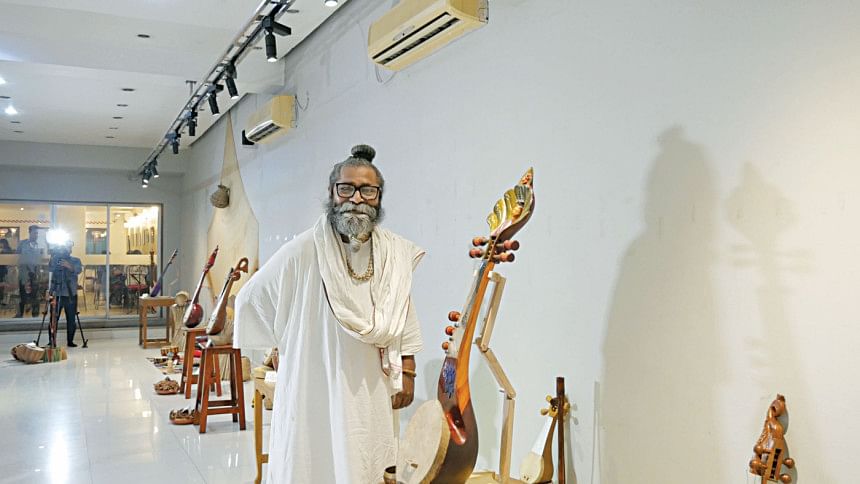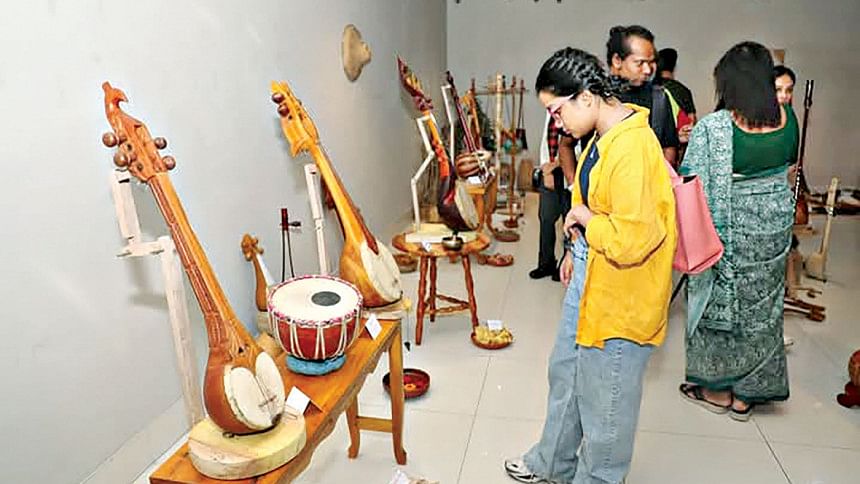Harmony of healing, where sound meets soul

Music is a language that transcends borders, speaking directly to the soul. It mends unseen wounds, bears the weight of shared histories, and offers glimpses into cultures, both near and distant.
Yet, it remains universally resonant, dissolving differences and finding a home in every heart.
This spirit defines "Harmony of Healing," an exhibition at Alliance Française de Dhaka, where instruments transcend their material form, becoming storytellers that bridge centuries-old traditions with the promise of a boundless musical future in the hands of contemporary artisans.
The instruments themselves are extraordinary, born of age-old techniques and daring experimentation. Some, like the gourd-crafted Ektaras, speak of wandering bards who turned whatever nature provided into vessels of sound.
Others are born of experimentation, blending science with a deep-rooted spirituality. Among the pieces on display, many are made from materials as humble as coconut shells, gourds, and wood.
At the heart of the event is Mohammad Jakir Hossain, a musician, philosopher, and craftsman, whose life's work reverberates through every instrument on display.
His work, though rooted in tradition, reflects a profound understanding of music as a force that heals and uplifts.
Jakir's journey, from studying computer science to the spiritual philosophies of Sufism and the teachings of Indian gurus, has culminated in a practice that is both deeply personal and universally accessible.
His vision has brought together a team of dreamers and craftsmen whose instruments are as much tools of sound as they are bridges to inner peace.

"Music and my love for it inspired me so much in this … To me, it is both sacred and spiritual. Most instruments here are made by me, and some I crafted alongside other makers.
"I trained myself first, and then I trained a few instrument makers in my locality. I've taken this as a research project, but my approach is different. I prefer living and internalising it."
Jakir and his team have experimented with different types of wood, refining their craft to create instruments that not only produce exquisite tones, but also embody the spirit of the heritage they represent.
The exhibition also includes a few restored instruments. "In this exhibition, I've seen instruments that are 150, maybe 200 years old," said Tapash Biswas, a visitor. "It feels like I've visited that time within a few minutes."
The event is more than an exhibition. Through interactive displays, live demonstrations, and curated performances, visitors are invited to experience how music binds us to our roots and one another.
Workshops offer hands-on sessions with folk instruments, allowing participants to soak themselves into the rhythms and melodies of Bengali traditions under the guidance of skilled musicians.
Another highlight of the event is the collaborative folk-art session, where artists create live artworks inspired by the music around them.
This interplay between visual and auditory art forms adds a new dimension to the experience. Healing sessions, meanwhile, provide a quieter space for introspection, inviting attendees to reconnect with their inner selves.
Folk musician Shafi Mandal, a guest at the inauguration, summed up the awe many felt for Jakir's vision. "He must be an eccentric person; otherwise, it's not possible. As a musician myself, I understand how much effort and passion it takes to be able to do such a thing."

In a city as restless as Dhaka, where the air hums with the sound of horns and hurried footsteps, finding stillness feels almost impossible. Yet, even amid the chaos, there are moments when something extraordinary cuts through the noise.
The exhibition, running until November 29, invites you in not with grandeur, but with an intimacy that asks you to slow down, listen closely, and let the music speak to you.

 For all latest news, follow The Daily Star's Google News channel.
For all latest news, follow The Daily Star's Google News channel. 



Comments